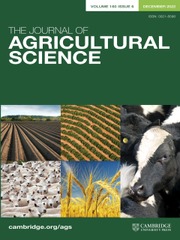Article contents
The digestion by cattle of silage and barley diets containing increasing quantities of fishmeal
Published online by Cambridge University Press: 27 March 2009
Summary
A 4 × 4 latin-square design experiment was carried out to determine the effects of increasing nitrogen (N) intake by feeding diets containing increasing amounts of fishmeal upon the digestion of organic matter (OM) and N by cattle equipped with rumen and duodenal cannulae. A basal diet (B) containing 600 g silage and 400 g ground barley/kg diet and three diets (BF1, BF2 and BF3) in which increasing amounts of the silage and barley basal diet were proportionately replaced by fishmeal were fed. The mean daily intakes of OM and N when each diet was fed were 4·29, 4·28, 4·22 and 4·20 kg OM and 90, 108, 125 and 143 g N for diets B, BF1, BF2 and BF3 respectively.
Neither the amounts of OM entering the small intestine nor those voided in the faeces were altered by the diets fed. Thus mean apparent OM digestibility for all the diets fed was 0·74 ± 0·007 and the proportion of digestible OM intake apparently digested in the rumen was 0·83±0·011.
Mean daily concentrations of ammonia N in the rumen were significantly (P <0·01) increased from 85 mg N/l (diet B) to 129 mg N/1 (diet BF3) as fishmeal intake increased.
The quantities of non-ammonia N (P <0·05) and of amino acid N (P <0·001) entering the small intestine were significantly increased as more fishmeal was added to the diets fed. As fishmeal intake increased apparent N digestibility was significantly (P <0·001) increased.
Neither the quantities of microbial N entering the small intestine daily nor the apparent efficiency of microbial N synthesis within the rumen were increased by the diets fed. The quantities of feed N entering the small intestine daily were significantly (P<0·01) increased as fishmeal intake increased; thus apparent feed N degradability in the rumen was significantly (P <0·05) decreased from 0·84 (diet B) to 0·73 (diet BF3) as fishmeal intake increased. Similarly, the rates of disappearance of N from each of the four barley or barley and fishmeal concentrates when incubated in the rumens of the cattle in porous synthetic fibre bags were decreased as the proportion of fishmeal in the concentrates increased. Thus, the rumen N degradability of the diets fed, when calculated from the rates of disappearance of N from porous synthetic fibre bags placed in the rumen, decreased as fishmeal intake increased.
As fishmeal intake increased the amino acid composition of duodenal digesta (expressed as g/kg determined amino acids) changed such that the content of arginine increased (P <0·01) and the content of isoleucine decreased (P <0·01). The concentrations of arginine (P <0·01), leucine and lysine (P <0·05) in blood plasma increased as fishmeal intake increased.
Information
- Type
- Research Article
- Information
- Copyright
- Copyright © Cambridge University Press 1987
References
- 12
- Cited by

